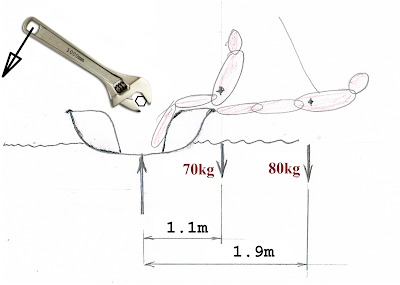Righting Moment - Sideforce calculation
When RM = HM heel angle is constant.
The distance between the centre of sail forces and centre of daggerboard forces is called Heeling Arm
HM divided by HA equals the Sideforce produced by the sails and wind, which is exactly reacted in the water by a combination of daggerboard area, leeway angle and boatspeed.
An important point is that the HM can't be greater than RM. To increase Sideforce, the Heeling Arm must be reduced by twisting and/or flattening the top of the sails.
Here is a simple calculator for RM of a dinghy that is being sailed upright.
Enter boat, crew, sail dimensions and calculate the RM and Sideforce.
Enter boatspeed, TWS and TWA and it estimates drag forces for friction, lift-induced drag, windage.
Righting Moment - Sideforce (Read the Manual page for instructions)
Currently the workbook has Laser and Bic data, but it can be expanded to other classes easily enough.
The Laser also has Wave Drag of the hull from published data.
In the case of the Bic the sideforce is predicted to be 12kg for a 45kg crew.
This is the total pressure force on the sail in the horizontal direction.
The sail transfers its force to the mast and boom, which in turn transfers the load into the deck & mastbase, and via the mainsheet.
A reasonable assumption is that 1/3 (4kg) is directly through the clew onto the end of the boom.
The mainsheet is attached 2/3 of the distance along the boom so a scale attached horizontally at the mainsheet would measure about 6kg.
Notes
- the vang needs to hold the leech firm as normal, with the mainsheet is slack.
- this is valid if the 45kg is fully hiked, boat flat, and the sail is not twisted
- if twisted, then the force will be higher because the Heeling Arm is less
- if not fully hiked, then the force will be lower because the Righting Moment is less - and therefore Heeling Moment and Sideforce are less.
- if the boat is heeled the force will be higher because the crew weight is furhter to windward of the buoyancy force of the hull
Exercises
- Run a tape measure over the boat to check the beam, daggerboard size, mast height etc.
- measure your centre of gravity by lying on a plank with a pivot. See how far over the gunwhale you can get it.
- measure the boom force as above
- try different board heights
- try different crew weight (note that the hull friction won't change - this is a simple calculator!)
To add more boats read the procedure on the Manual tab, and/or contact me.



Comments
Post a Comment